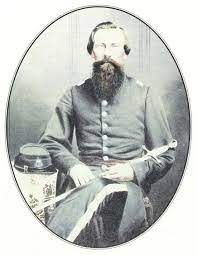CAPTAIN LYLE AND HIS CAPTURE OF 600 YANKEES
Posted By : manager
Posted : October 4, 2022
By: Mike Thomas
October 27, 1 864 promised to be another day of battle for Captain Joseph Banks Lyle, 5th South Carolina Infantry. A seasoned soldier with service dating to April 13, 1861, he was in command of skirmishers for Bratton’s Brigade in Field’s Division that day. He considered himself an educator and looked forward to continuing that vocation in the future. Born in Fairfield County SC in 1829, he was a graduate of South Carolina College and a pre-war headmaster at a boy’s school in York, SC.
The expected battle found Confederate forces along a portion of Richmond’s outer defensive line grossly outnumbered by Union forces poised to their front. It marked the first action under Lt. General James Longstreet since being wounded at The Wilder-ness several months earlier. After a series of Union feints, Longstreet determined the real threat was at undefended works farther down the lines at Williamsburg Road and dispatched Field’s entire division to occupy that position. Confederate cavalry had engaged and routed a much larger Union cavalry command there that morning but was no longer in that area.
Longstreet’s hunch proved prophetic for no sooner had Field’s men “Captain Lyle”, continued from page 1
occupied the works then a Union assault commenced. The Yankees, believing the position to be undefended, advanced unhurriedly from their starting point about a mile away. They were caught in the open and totally shocked when Field’s men opened fire on them. Those not hit either fled the scene or took shelter in a number of nearby gullies. Seeing no chance of success for the attack, their only thoughts centered on escaping their predicament. The Yankees soon realized the gullies led back to their starting point and began dashing from one gulley to another in hope of escaping the killing field under the covering fire of their artillery and approaching darkness. Captain Lyle, sensing the enemy was beaten and demoralized, felt they would surrender if he was allowed to take his skirmishers forward. His request to do so was denied and many more Union soldiers escaped. Lyle did not want to have to fight these Yankees again on another day when he felt they could be so easily captured. Accordingly, of his own volition, he stepped off alone from Confederate lines to demand their surrender. Confederate forces on each end of the lines, thinking Lyle was a deserter, opened fire on him. Word quickly spread that this was not the case & the firing was ceased.
Upon reaching the main part of the remaining Union force several hundred yards away, Lyle audaciously announced they were now his prisoners and instructed the forlorn Yankees to march toward the Confederate line…and they began doing so! After about half had filed away, a Union officer challenged him urging his men not to surrender to a single Confederate soldier, but to pick up arms and fight. Lyle reacted quickly by picking up a carbine left from the earlier cavalry engagement and advanced on the officer threatening to “blow his brains out” if he did not surrender at once. The threat worked and the officer joined those marching to Confederate lines. Captain Lyle wrote in his diary he captured at least 400 Yankees before the skirmishers finally were sent to support him. Afterward, he was officially credited with virtually single-handedly capturing between 500 and 600 prisoners. That night, when all was quiet, Lyle learned the carbine he had used was empty. Generals Longstreet, Field, and Bratton each cited him for this outstanding display of personal courage and accomplishment. The Confederate War Department promoted him to Major in March 1865, but the fall of Richmond prevented the commission from ever reaching him.
